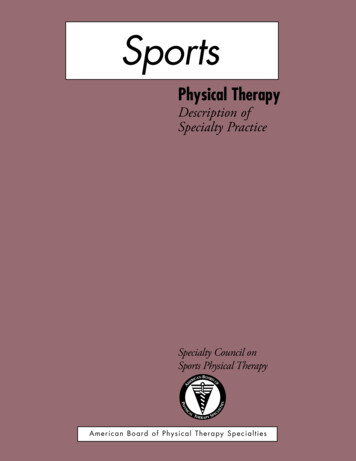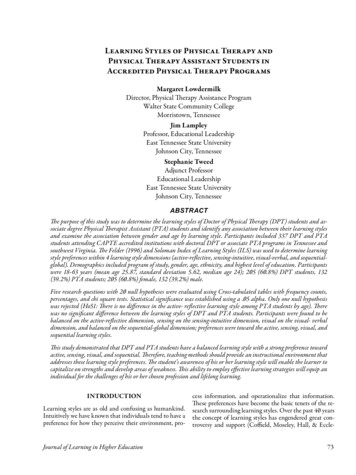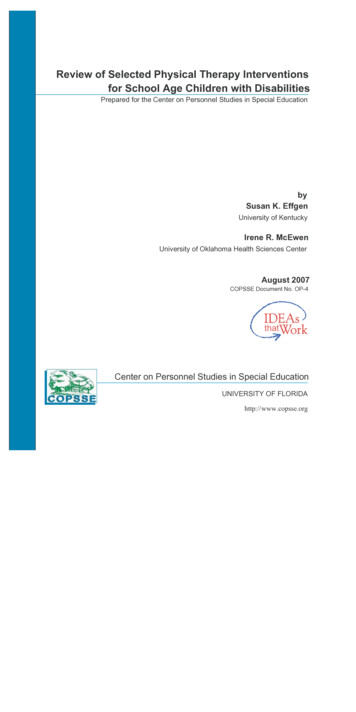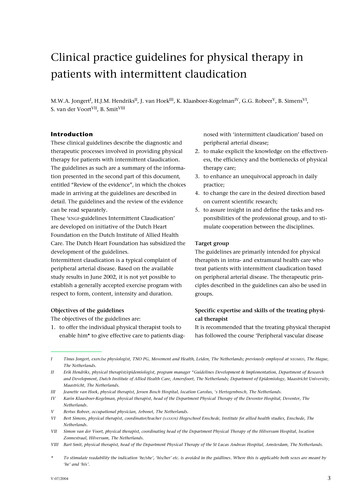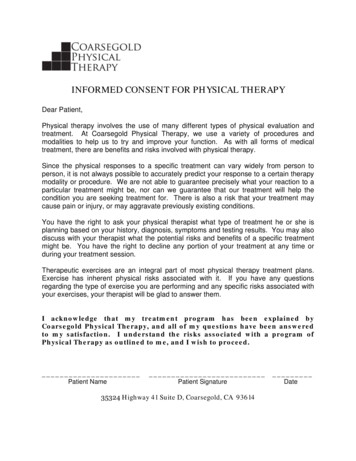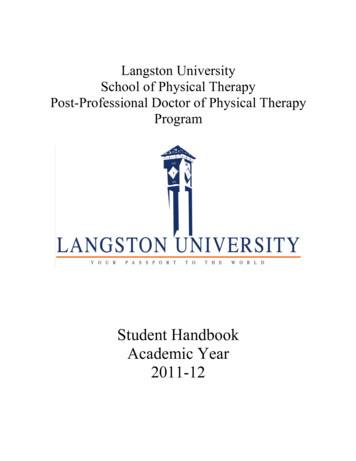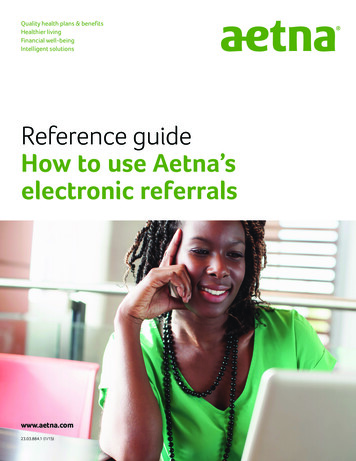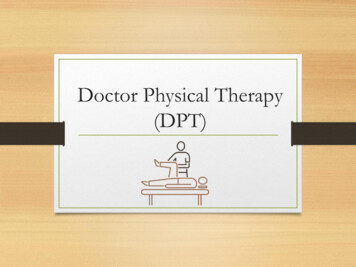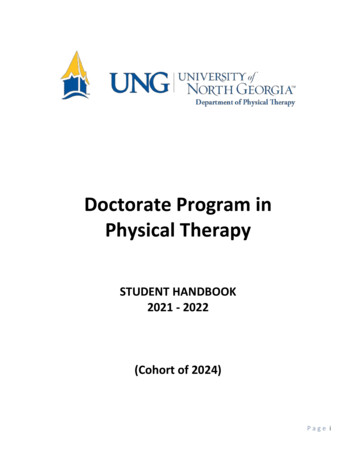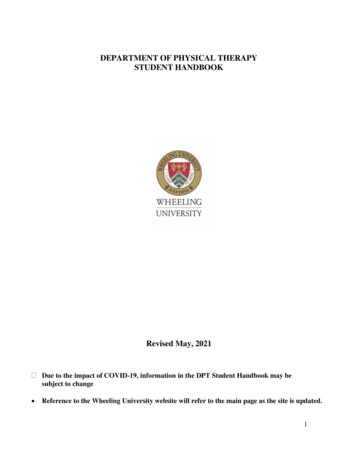
Transcription
DEPARTMENT OF PHYSICAL THERAPYSTUDENT HANDBOOKRevised May, 2021 Due to the impact of COVID-19, information in the DPT Student Handbook may besubject to change Reference to the Wheeling University website will refer to the main page as the site is updated.1
TABLE OF CONTENTS0.00. 1.61.71.81.91.101.11INTRODUCTION . 6Purpose of Physical Therapy Student Handbook. 6Updating the Physical Therapy Student Handbook . 6Instructions . 6The Curriculum . 8Introduction to Problem-Based Learning . 8Mission and Philosophy . 9Mission Statement . 9Statement of Philosophy . 9Principles and Values of the Program: . 9Program Goals . 10Competencies of Graduates. 13Course Formats . 13Clinical Science (Tutorials). 13Basic Science. 14Physical Therapy Science . 15Professional Issues . 15Research and Evidence Based Practice . 16Integrated Seminar . 16Service Learning . 16Clinical Education . 17Clinical Education Sites . 18The Accreditation Process. 18Licensure Requirement . 19American Physical Therapy Association (APTA) . 19THE STUDENT MEMBER AND THE UNIVERSITY . 20Code of Conduct: . 20Academic Integrity . 20Essential Functions . 27Disability Accommodations . 27The Student Success Center .28Emergency Messages . 28Regular and Appropriate Use of Email . 29Change of Student Information . 29Housing . 29Class Cancellation . 30Transfer of Credits . 302
16.12.16.22.16.3Graduation . 31Graduating with Honors . 31Respect for Facility . 31Privacy . 32Use of Classrooms . 33Use of Tutorial Rooms . 33Extracurricular Activities . 33Physical Therapy (PT) Club . 33Sexual Misconduct . 34Equal Employment Opportunity Officer. 34Health Records . 34University Student Health Center . 35THE STUDENT MEMBER AND THE PHYSICAL THERAPY PROGRAM. 35General Department Information . 35Offices . 35Telephone Numbers and Policies . 36Committees. 36Admissions Committee . 36Curriculum Committee. 36Advisory Committee . 36Academic Progress Committee . 36Accreditation Committee . 37Service Learning Committee. 37Faculty Roles . 37Food and Beverages in the Classroom .38Use of Physical Therapy Facilities. 39Attendance . 39Tardiness . 39Timeliness of Assignments . 40Announcements . 40Use of Office Facilities . 40Request for References and Transcripts 40Use of Software in the Computer Lab .41Use of Duplication and Scanning of Documents . 41Incident Reports . 41Obtaining Informed Consent . 41Academic Regulations. 41Introduction . 41Style Manual . 42Maintenance and Confidentiality of Student Education Records . 423
.22.36Academic/Professional Behavior Probation . 43Academic Suspension . 44Dismissal . 44Course Remediation . 45Repeating a Course. 45Incomplete Grades. 46Withdrawal . 46Re-admission to the Program . 47Learning Contracts . 47Examination Review Policy . 47Class Participation . 48Grading . 48Student Examination Formats . 49Multiple Choice Questions (MCQ) . 49Modified Essay Questions (MEQ) . 49Triple Jump . 49Objective Structured Clinical/Comprehensive Examination (OSCE) .50Comprehensive Examinations . 50Checkout/Competency Assessments. 55Take-Home Examinations . 55Regulations for Passing/Failing of Exams . 55Noncompliance with Rules of Academic Integrity and Conduct. .56Appeals Procedure. 58Departmental Grievance Procedure . 58Level One . 58Level Two. 58Level Three. 58Withdrawal of Complaint . 59Hearing and Decisions . 59Reprisal and Retaliation . 59Faculty Advisement. 59Advancement in the Physical Therapy Curriculum . 59Student Progress Assistance . 60Permission to Participate in Clinical Education . 60Professional Behavior Expectations. 61Social Media . 62Basic Science Room . 63Physical Therapy Science . 63Safety . 64Physical Therapy Science Dress Code . 65Classroom Dress Code . 664
3.10Professional Dress Code. 66Student Governance . 66Student Evaluation of Courses and Curriculum. 67Estimated Costs of Professional Education . 67FSBPT Examination Testing Policy . 68APPENDICES . 69Department Mission . 70APTA Vision Statement for the Physical Therapy Profession . 71Curriculum Schedules 74Essential Functions for Physical Therapy Students . 77Adult Model Permission and Release Form . 78Student Evaluation of DCE 80Process for Graduation and Licensure . 82Federation of State Boards Mission Statement 83Model Practice Act . 84Survey of Graduates . 1055
0.0INTRODUCTION0. 1Purpose of Physical Therapy Student HandbookThe Physical Therapy (PT) Student Handbook was prepared as a preliminaryannouncement of policies and procedures designed to promote understandingand mutual respect among faculty, staff, and graduate students within thephysical therapy program (referred to herein as the “Program”).Students enrolled in the Program are also subject to, and should be familiarwith, the policies and procedures set forth in the University’s StudentHandbook, located on the University’s website. In the case of anydifferences between the policies and procedures in the University’s StudentHandbook and those in the PT Student Handbook, the policies and proceduresin the PT Student Handbook will govern the Program.0.2Updating the Physical Therapy Student HandbookChange and adjustment in the Program are normal and expected. The PTStudent Handbook is updated yearly and is otherwise subject to revisionbased upon feedback from multiple sources, including but not limited to,Department of Physical Therapy faculty and director, members of Universityadministration, as well as external sources such as the Federation of StateBoards of Physical Therapy and the Program’s accreditation agency. Studentinput is also earnestly solicited. All feedback received is considered carefullyand incorporated into the document as appropriate.Notice of any updates to the PT Student Handbook will be provided in theform of an email announcement and/or distribution of additional/replacementpages. Additionally, the version of the PT Student Handbook published onthe University’s website will be kept current to reflect any updates. Changesto the PT Student Handbook are effective and enforceable immediatelyunless otherwise noted.0.3Compliance Agreements0.3.1 InstructionsIt is each student’s responsibility to thoroughly review the PT StudentHandbook. The Department also recommends that each student review6
relevant sections of the University Student Handbook, as identified in the PTStudent Handbook.The PT Student Handbook is available on the Blackboard AUX - DPTResources course. Students must access the Blackboard course, review theHandbook, and sign the Student Handbook Acknowledgement documentwhich is listed as an assignment in the Blackboard AUX- DPT Resourcescourse. The PT Student Handbook is updated annually.All incoming/current students must access the Blackboard course, reviewthe Handbook, and sign the Student Handbook Acknowledgementdocument by the designated due date annually.The Handbook will also be reviewed live during the on-campus orientationbefore the start of Term II. The orientation date and time will be sent to allstudents electronically.0.4Physical Therapy Student Handbook Initial Student Feedback FormInstructions: After reviewing the PT Student Handbook during orientation,you will be asked to complete the Physical Therapy Student Handbook InitialStudent Feedback Form using an electronic survey. The link will be given toyou during orientation. Please keep the following questions in mind as youread the Handbook. The Department of Physical Therapy values yourcontinued feedback on the PT Student Handbook. Students may submitfurther suggestions/feedback in writing to the Department Chair.1. The PT Student Handbook describes clearly the policies and proceduresdesigned to promote understanding and mutual respect among faculty, staff,and graduate students enrolled in the Program.321Very clear descriptionsClear descriptionsDescriptions not clearSuggestions for improvement:2. The PT Student Handbook will help you plan (time management, finances,etc.) for your next two years.321Will help a great dealWill help moderatelyWill be of no helpSuggestions for improvement:7
3. The organization of the PT Student Handbook allowed you to locateinformation:321Very easily foundEasily foundDifficult to findSuggestions for improvement:4. Do you believe that the contents of the PT Student Handbook arecomplete?321Too much materialJust rightToo little materialSuggestions for improvement:5. Do you have any issues or concerns with the contents of the PT StudentHandbook?YesNoIf yes, please explain: Other suggestions or comments concerning the PTStudent Handbook:0.5The Curriculum0.5.1 Introduction to Problem-Based LearningThe problem-based learning model was selected for this curriculum becauseof its capacity for establishing a systematic clinical decision-making pattern,promoting development of skills in teamwork, developing student skills incritical analysis, and transmitting professional knowledge, skills andattitudes. The model stresses the process of learning as well as the contentof learning.These abilities are important to the practice of physical therapy today andwill be even more important as the profession promotes Doctor of PhysicalTherapy as autonomous and reflective practitioners. They will guide itsadaptation to the information explosion, managed care models, health careand information technologies, and other changes in health care delivery.Problem-based learning is well suited to a graduate professional programbecause of its emphasis on adult learning models, student responsibility forlearning, and other behaviors. It facilitates sharing the diverse educational8
and experiential backgrounds of students and faculty members. It promotesuse of a variety of learning styles and fosters creativity. Problem-basedlearning is student-centered and focuses on learning rather than on teaching.Student responsibility for identifying a need for information, locating andevaluating information, and assessing the performance of themselves andothers is central to this approach.The mission and philosophy statements of the Department of PhysicalTherapy (the “Department”), curriculum objectives, and competenciesexpected of graduates are provided to promote student understanding of thecurriculum design.0.5.2 Mission and Philosophy0.5.2.1 Mission StatementBuilding a holistic education experience to empower our students, graduates, andeducators to demonstrate excellence in leadership, scholarship, and service and to provideour stakeholders graduates who foster evidence-based best clinical practice forcomprehensive rehabilitation across the lifespan.0.5.2.2 Statement of PhilosophyThe Program provides a learning environment conducive to the education ofexcellent problem-solving clinicians and the professional development of thefaculty and students in research and intellectual inquiry. Delivery ofhealthcare in an ethical, efficient, and effective manner is provided tohealthcare consumers, including service to the underserved locally,nationally, and internationally. This program’s philosophy is integrated withthe University and Department mission statements by including educationalprinciples of the basic sciences, clinical practice, research, andprofessionalism.0.5.2.3 Principles and Values of the Program:1.2.Students are provided with a strong foundation for clinical practice bythe inclusion of the basic sciences of anatomy, physiology,neuroscience, exercise physiology, and kinesiology.Students engage in clinical practice experiences through clinicaleducation experiences throughout the curriculum in a variety ofsettings.9
3.4.5.6.7.8.Students are required to research and utilize the principles of evidencebased practice and topics related to its ethical application.Students are expected to demonstrate professionalism in all aspects ofthe Program and to be culturally competent practitioners.The Program values the problem-based learning approach as well asthe variety of service-learning opportunities.The Program values a learning environment conducive to theeducation of excellent problem-solving clinicians and the professionaldevelopment of the faculty and students in research and intellectualinquiry.Students are encouraged to deliver healthcare in an ethical andeffective manner.The Program provides opportunities for the students and faculty toprovide service to the underserved locally, regionally andinternationally.0.5.3 Program GoalsThe Program follows the student outcomes in three domains: Cognitive,Affective, and Psychomotor.The Department has identified the below goals for its students, faculty, andProgram. These goals should be viewed as guidelines and aspirations, not aspromises, or guarantees.Program Outcomes:1.To prepare the students as competent Doctor of Physical Therapy.2.Upon completion of the program, the student will demonstrate the ability tocomprehend, apply, and evaluate the information relevant to the role as an entrylevel physical therapist (Cognitive).3.Upon completion of the program, the student will demonstrate behaviors consistentwith professional and employer expectations (Affective).4.Upon completion of the program, the student will demonstrate technical proficiencyin all the skills necessary to fulfill the role as an entry level physical therapist(Psychomotor).5.To fulfill employment needs for Doctors of Physical Therapy within the local andregional service areas.6.Produce enough numbers of graduates to fill the positions created by turnoverand/or expansion in the health care market, nationally.7.The students will provide service to the community.10
Faculty Goals:1.The core faculty of the Doctor of Physical Therapy Program willdemonstrate excellence in advancing knowledge in the field throughtheir research, scholarship, teaching, and/or clinical practice.2.All core faculty members who have been with the University for atleast 5 years will take part in at least 5 peer reviewed events every 10years.3.All Clinical Track core faculty members will maintain expertise intheir designated areas.4.The core faculty of the Doctor of Physical Therapy Program will berole models in service to others by working with the students and otherprofessionals locally, regionally, and internationally.5.All core faculty members will participate in at least one category ofservice learning during each academic year.6.The faculty of the Doctor of Physical Therapy Program will remaintrue to the techniques that define the program as a problem-basedlearning environment.7.An assessment of practices with an outside expert or in-house reviewwill confirm that we have remained true to the problem-based learningformat.8.All tenure track core faculty members will have completed a postprofessional doctorate degree within 5 years of initial full-timeemployment.9.Tenure track faculty without completed post-professional doctoratedegrees will be successful in the tenure process.10. All clinical track core faculty will have completed a Doctor of PhysicalTherapy degree and have documented an area of specialization within5 years of initial full-time employment.11. Clinical Track faculty members without a completed Doctor ofPhysical Therapy degree will be successful in the clinical track multiyear contract process.12. All core faculty members will be members of the APTA and attend atleast one national conference every two years.13. All core faculty members will have access to the APTA resources.Program Goals:1.The Program will continually modify the curriculum to meet currentstandards of practice.2.The department will complete regular curricular reviews.3.All vacant core faculty positions will be filled.4.The Department will adhere to and maintain the Physical Therapy11
5.6.7.8.9.10.11.Policy and Procedure Manual.All program physical therapy professional faculty will maintain anactive physical therapy license.The Physical Therapy Department web page will be informative tostudents and provide information needed for anyone interested inapplying to the Program.The Physical Therapy Department webpage will accurately reflect theDepartment.A formal peer evaluation of all adjunct and associated faculty will becompleted annually.All adjunct and associated faculty members will have at least one classevaluated by a core faculty member every year.The Program will continually upgrade technology to state-of-the-artstandards.Core faculty will agree that needed technology is available to thestudents and faculty members.Narrative:The stated missions of both the University and the Department call foreducational excellence and service to others. From the mission, thephilosophy of the Department was developed. “Excellence” is accessed viathe program outcomes that compare the cognitive, psychomotor andaffective objectives of the program with the content of the Normative Modeland the Guide to Physical Therapist Practice as well as the results of thenational board exams and the results of the graduate and employer surveys.All of the program outcomes are derived directly from the Departmentmission statement as evidenced in Appendix 3.1: Department Mission.Faculty goals are also derived directly from the Department Mission,relating to research, service, problem based learning and professionaldevelopment. The first faculty goal matches the component of research inthe mission. The second faculty goal addresses the service component of themission with the service- learning program providing opportunities forfaculty to demonstrate competence in the field of physical therapy bymentoring students while they provide care for patients and solve problemsboth in the local and international community. The Program goals reflectthe Program’s mission by keeping the Department focused on educationalexcellence, service, professional development and the unique learning stylethat the problem- based learning curriculum provides.12
0.5.4 Competencies of GraduatesThere are several ways in which the competency of the students andgraduates is measured. The academic regulations are discussed in the PTStudent Handbook (see section 2.16). The progress of the students ismonitored by the faculty and by the Academic Progress Committee (seesection 2.2.4). Comprehensive examinations, modeled after the licensureexamination, are given throughout the Terms. The Physical TherapistClinical Performance Instrument (PT CPI) is utilized in each of the clinicaleducation experiences. Although the licensure examination is a measure ofcompetency, the Department faculty believes this to be the minimalstandard. The faculty members strive to prepare our graduates to exceedexpectations of employers upon graduation as measured by the highemployment rates and graduate survey results of alumni and theiremployers.0.5.5 Curriculum Schedule (Appendix 3.3)The Program attempts to follow the University calendar whenever possible.Some exceptions to this exist due to the structure of our year-round program.The Terms and breaks for physical therapy students can be found inAppendix 3.3, Curriculum Schedules. Adjustments will be made as necessaryafter due consideration of the impact on students. Changes will be announcedto students as clearly and expeditiously as possible.0.5.6 Course Formats0.5.6.1 Clinical Science (Tutorials)These sessions are central to the tutorial process. Tutorial groups includeeight to ten students and a faculty tutor. This class meets for 2.5-hour sessionstwice per week. Sessions focus on carefully developed patient cases. Thetutor assists students to manage group dynamics and to direct attention torelevant aspects of the case. In Terms II and III the tuto
0. 1 Purpose of Physical Therapy Student Handbook The Physical Therapy (PT) Student Handbook was prepared as a preliminary announcement of policies and procedures designed to promote understanding and mutual respect among faculty, staff, and graduate students within the physical therapy program (referred to herein as the "Program").
